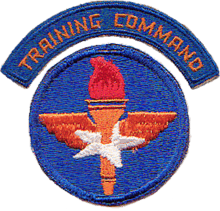34th Flying Training Wing (World War II)
| 34th Flying Training Wing | |
|---|---|
_-_Map.png) Locations of airfields controlled by the 34th Flying Training Wing | |
| Active | 1942-1946 |
| Country |
|
| Branch |
|
| Type | Command and Control |
| Role | Training |
| Part of | Army Air Forces Training Command |
| Engagements |
|
The 34th Flying Training Wing was a wing of the United States Army Air Forces. It was last assigned to the Central Flying Training Command, and was disbanded on 16 June 1946 at Midland Army Airfield, Texas.
There is no lineage between the United States Air Force 34th Training Wing, established on 20 November 1940 as the 34th Bombardment Group (Heavy) at Langley Field, Virginia, and this organization.
History
The wing supervised Training Command Flight Schools in Central and Northern Texas and Oklahoma. The assigned schools provided specialized training for bombardiers, and the wing was the home of the "West Texas Bombardier Quadrangle" schools (Childress, Midland, San Angelo, and Big Spring Army Airfields).[1]
The wing also provided specialized schools for training on the two-engine Martin B-26 Marauder medium bomber (Dodge City, Laughlin Army Airfields), and the B-24 Liberator four-engine heavy bomber (Fort Worth, Liberal Army Airfields). After graduation Air Cadets were commissioned as Second Lieutenants, received their "wings" and were reassigned to Operational or Replacement Training Units operated by one of the four numbered air fores in the zone of interior.[1]
As training requirements changed during the war, schools were activated and inactivated or transferred to meet those requirements.[1]
Lineage
- Established as 34th Flying Training Wing on 17 December 1942
- Activated on 8 January 1943
- Disbanded c. 16 June 1946[2]
Assignments
- AAF Gulf Coast Training Center (later Central Flying Training Command), 8 January 1943 – 16 June 1946 [2]
Training aircraft
The schools of the wing used primarily the Beechcraft AT-11 for bombardier training.
- Two-Engine training was performed on the Martin B-26 Marauder
- Four-Engine training was performed on the Consolidated B-24 Liberator
Assigned Schools
|
|
Stations
- San Angelo Army Airfield, Texas, 8 January 1943
- Midland Army Airfield, Texas, 25 May 1945 – 16 June 1946[2]
See also
- Army Air Forces Training Command
- Other Central Flying Training Command Flight Training Wings:
- 31st Flying Training Wing (World War II) Primary Flight Training
- 32d Flying Training Wing (World War II) Basic Flight Training
- 33d Flying Training Wing (World War II) Advanced Flight Training, Two Engine
- 77th Flying Training Wing (World War II) Advanced Flight Training, Single Engine
- 78th Flying Training Wing (World War II) Classification/Preflight Unit
- 80th Flying Training Wing (World War II) Navigation and Glider
References
![]()
- 1 2 3 Manning, Thomas A. (2005), History of Air Education and Training Command, 1942–2002. Office of History and Research, Headquarters, AETC, Randolph AFB, Texas ASIN: B000NYX3PC
- 1 2 3 34th Flying Training Wing, lineage and history document Air Force Historical Agency, Maxwell AFB, Alabama
- ↑ "www.accident-report.com: Big Spring Army Airfield". Archived from the original on 7 October 2014. Retrieved 21 March 2014.
- ↑ "www.accident-report.com: Childress Army Airfield". Archived from the original on 7 October 2014. Retrieved 21 March 2014.
- ↑ "www.accident-report.com: Dodge City Army Airfield". Archived from the original on 11 March 2014. Retrieved 21 March 2014.
- ↑ "www.accident-report.com: Fort Worth Army Airfield". Archived from the original on 7 October 2014. Retrieved 21 March 2014.
- ↑ "www.accident-report.com: Laughlin Army Airfield". Archived from the original on 7 October 2014. Retrieved 21 March 2014.
- ↑ "www.accident-report.com: Liberal Army Airfield". Archived from the original on 11 March 2014. Retrieved 21 March 2014.
- ↑ "www.accident-report.com: Midland Army Airfield". Archived from the original on 7 October 2014. Retrieved 21 March 2014.
- ↑ "www.accident-report.com: San Angelo Army Airfield". Archived from the original on 7 October 2014. Retrieved 21 March 2014.
